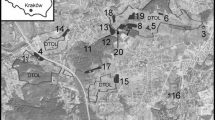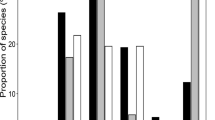Abstract
Climate change is expected to drive patterns of extinction and colonisation that are correlated with geographic gradients in the climate, such as latitude and elevation. However, local population dynamics also depend on the fine-scale effects of vegetation and topography on resource availability and microclimate. Understanding how this fine-scale variation influences population survival in the face of changing climatic favourability could provide clues for adapting conservation to climate change. Here, we document a long-term decline of the butterfly Parnassius apollo in the Sierra de Guadarrama mountain range in central Spain, and examine recent population turnover and habitat use by the species to make inferences about its ecology and conservation. A decline since the 1960s throughout the elevation range suggests a regional deterioration in favourability for the species. Since 2006, local habitat quality has been the main correlate of population persistence, with populations that persisted from 2006 to 2012 associated with high availability of larval host plants. At a finer resolution, the larval distribution in a network of suitable habitat in 2011 and 2012 was most closely related to bare ground cover. Thus, although slope, aspect and elevation lead to considerable variation in microhabitat temperatures during the period of P. apollo larval development, vegetation structure appears to have been the most critical factor for local habitat use and population persistence. The results show that site selection and management retain key roles in conservation despite the broad-scale effects of environmental change.





Similar content being viewed by others
References
Ashton S, Gutiérrez D, Wilson RJ (2009) Effects of temperature and elevation on habitat use by a rare mountain butterfly: implications for species responses to climate change. Ecol Entomol 34:437–446
Bartoń K (2013) Package MuMIn: Multi-model inference. R package version 1.9.13. http://CRAN.R-project.org/package=MuMIn. Accessed 25 April 2014
Baz A (2002) Nectar plants for the threatened Apollo butterfly (Parnassius apollo L. 1758) in populations of central Spain. Biol Conserv 103:277–282
Beever EA, Brussard PF, Berger J (2003) Patterns of apparent extirpation among isolated populations of pikas (Ochotona princeps) in the Great Basin. J Mammal 84:37–54
Bennie J, Hodgson JA, Lawson CR, Holloway CTR, Roy DB, Brereton T, Thomas CD, Wilson RJ (2013) Range expansion through fragmented landscapes under a variable climate. Ecol Lett 16:921–929
Boggs CL, Inouye DW (2012) A single climate driver has direct and indirect effects on insect population dynamics. Ecol Lett 15:502–508
Burnham KP, Anderson DR (2002) Model selection and multimodel inference: a practical information-theoretic approach, 2nd edn. Springer, New York
Chen I, Hill JK, Ohlemüller R, Roy DB, Thomas CD (2011a) Rapid range shifts of species associated with high levels of climate warming. Science 333:1024–1026
Chen I, Hill JK, Shiu H, Holloway JD, Benedick S, Chey VK, Barlow HS, Thomas CD (2011b) Asymmetric boundary shifts of tropical montane Lepidoptera over four decades of climate warming. Glob Ecol Biogeogr 20:34–45
de las Heras P, Fernández-Sañudo P, López-Estébanez N, Roldán MJ (2011) Territorial and boundary effects in a protected area of the Central Iberian Peninsula. Cent Eur J Geosci 3:1–11
Deschamps-Cottin M, Roux M, Descimon H (1997) Valeur trophique des plantes nourricières et préférence de ponte chez Parnassius apollo L. (Lepidoptera, Papilionidae). CR Acad Sci III-Vie 320:399–406
Descimon H, Bachelard P, Boitier E, Pierrat V (2005) Decline and extinction of Parnassius apollo populations in France-continued. In: Kühn E, Feldmann R, Thomas JA, Settele J (eds) Studies on the ecology and conservation of butterflies in Europe, vol 1., General concepts and case studiesPensoft, Sofia pp, pp 114–115
ESRI (2001) ArcGIS 8.1. Environmental Systems Research Institute Inc, Redlands
Farr TG, Rosen PA, Caro E et al (2007) The shuttle radar topography mission. Rev Geophys 45:RG2004
Franco AMA, Hill JK, Kitschke C, Collingham YC, Roy DB, Fox R, Huntley B, Thomas CD (2006) Impacts of climate warming and habitat loss on extinctions at species’ low-latitude range boundaries. Glob Chang Biol 12:1545–1553
Fred MS, Brommer JE (2005) The decline and current distribution of Parnassius apollo (Linnaeus) in Finland: the role of Cd. Ann Zool Fenn 42:69–79
Fu P, Rich PM (2000) The solar analyst 1.0 user manual. Helios Environmental Modelling Institute, Lawrence
García-Barros E, Munguira ML, Cano JM, Romo H, Garcia-Pereira P, Maravalhas ES (2004) Atlas of the butterflies of the Iberian Peninsula and Balearic Islands (Lepidoptera: Papilionoidea and Hesperioidea). Sociedad Entomológica Aragonesa, Zaragoza
Gillingham PK, Palmer SCF, Huntley B, Kunin WE, Chipperfield JD, Thomas CD (2012) The relative importance of climate and habitat in determining the distributions of species at different spatial scales: a case study with ground beetles in Great Britain. Ecography 35:831–838
Giménez-Benavides L, Escudero A, Iriondo JM (2007) Reproductive limits of a late-flowering high-mountain Mediterranean plant along an elevational climate gradient. New Phytol 173:367–382
Gutiérrez Illán J, Gutiérrez D, Wilson RJ (2010) The contributions of topoclimate and land cover to species distributions and abundance: fine resolution tests for a mountain butterfly fauna. Glob Ecol Biogeogr 19:159–173
Gutiérrez D, Wilson RJ (2014) Climate conditions and resource availability drive return elevational migrations in a single-brooded insect. Oecologia 175:861–873
Gutiérrez D, Harcourt J, Díez SB, Gutiérrez Illán J, Wilson RJ (2013) Models of presence–absence estimate abundance as well as (or even better than) models of abundance: the case of the butterfly Parnassius apollo. Landsc Ecol 28:401–413
Hanski I (1999) Metapopulation ecology. Oxford University Press, Oxford
Lawson CR, Bennie J, Thomas CD, Hodgson JA, Wilson RJ (2012) Local and landscape management of an expanding range margin under climate change. J Appl Ecol 49:552–561
Lawson CR, Bennie J, Hodgson JA, Thomas CD, Wilson RJ (2014) Topographic microclimates drive microhabitat associations at the range margin of a butterfly. Ecography 37:732–740
Merrill RM, Gutiérrez D, Lewis OT, Gutiérrez J, Díez SB, Wilson RJ (2008) Combined effects of climate and biotic interactions on the elevational range of a phytophagous insect. J Anim Ecol 77:145–155
Monserrat VJ (1976) La distribución ecológica de las mariposas diurnas del Guadarrama. Tesis, Universidad Complutense de Madrid, Madrid
Moritz C, Patton JL, Conroy CJ, Parra JL, White GC, Beissinger SR (2008) Impact of a century of climate change on small-mammal communities in Yosemite National Park, USA. Science 322:261–264
Nieminen M, Nuorteva P, Tulisalo E (2001) The effect of metals on the mortality of Parnassius apollo larvae (Lepidoptera: Papilionidae). J Insect Conserv 5:1–7
O’Connor RS, Hails RS, Thomas JA (2014) Accounting for habitat when considering climate: has the niche of the Adonis blue butterfly changed in the UK? Oecologia 174:1463–1472
Oliver TH, Roy DB, Brereton T, Thomas JA (2012) Reduced variability in range-edge butterfly populations over three decades of climate warming. Glob Chang Biol 18:1531–1539
Parmesan C (2006) Ecological and evolutionary responses to recent climate change. Annu Rev Ecol Evol Syst 37:637–669
Parmesan C, Yohe G (2003) A globally coherent fingerprint of climate change impacts across natural systems. Nature 421:37–42
Parmesan C, Ryrholm N, Stefanescu C et al (1999) Poleward shifts in geographical ranges of butterfly species associated with regional warming. Nature 399:579–583
Pollard E, Yates TJ (1993) Monitoring butterflies for ecology and conservation. Chapman and Hall, London
R Development Core Team (2014) R: a language and environment for statistical computing. R Foundation for Statistical Computing, Vienna, Austria. http://www.R-project.org/. Accessed 17 March 2014
Richards SA (2005) Testing ecological theory using the information-theoretic approach: examples and cautionary results. Ecology 86:2805–2814
Richards SA (2008) Dealing with overdispersed count data in applied ecology. J Appl Ecol 45:218–227
Roland J, Matter SF (2007) Encroaching forests decouple alpine butterfly population dynamics. Proc Natl Acad Sci USA 104:13702–13704
Roland J, Matter SF (2013) Variability in winter climate and winter extremes reduces population growth of an alpine butterfly. Ecology 94:190–199
Sánchez-Rodríguez JF, Baz A (1996) Decline of Parnassius apollo in the Sierra de Guadarrama, Central Spain (Lepidoptera: Papilionidae). Holarct Lepid 3:31–36
Schmeller DS, Dolek M, Geyer A, Settele J, Brandl R (2011) The effect of conservation efforts on morphological asymmetry in a butterfly population. J Natl Conserv 19:161–165
Settele J, Kudrna O, Harpke A et al (2008) Climatic risk atlas of European butterflies. BioRisk 1 special issue. Pensoft, Sofia-Moscow
Suggitt AJ, Gillingham PK, Hill JK, Huntley B, Kunin WE, Roy DB, Thomas CD (2011) Habitat microclimates drive fine-scale variation in extreme temperatures. Oikos 120:1–8
Sunday JM, Bates AE, Dulvy NK (2012) Thermal tolerance and the global redistribution of animals. Nat Clim Chang 2:686–690
Thomas CD (2010) Climate, climate change and range boundaries. Divers Distrib 16:488–495
Thomas CD, Franco A, Hill JK (2006) Range retractions and extinction in the face of climate warming. Trends Ecol Evol 21:415–416
Tingley MW, Beissinger SR (2009) Detecting range shifts from historical species occurrences: new perspectives on old data. Trends Ecol Evol 24:625–633
Tolman T, Lewington R (1997) Butterflies of Britain and Europe. HarperCollins, London
Van Swaay C, Cuttlelod A, Collins S et al (2010) European red list of butterflies. Publications Office of the European Union, Luxembourg
Weiss SB, Murphy DD, White RR (1988) Sun, slope and butterflies: topographic determinants of habitat quality for Euphydryas editha. Ecology 69:1486–1496
Wilson RJ, Gutiérrez D (2012) Effects of climate change on the elevational limits of species ranges. In: Beever EA, Belant JL (eds) Ecological consequences of climate change: mechanisms, conservation, and management. Taylor and Francis, Boca Raton, pp 107–131
Wilson RJ, Gutiérrez D, Gutiérrez J, Martínez D, Agudo R, Monserrat VJ (2005) Changes to the elevational limits and extent of species ranges associated with climate change. Ecol Lett 8:1138–1146
Acknowledgments
V. J. Monserrat provided access to historical data. J. Gutiérrez Illán, J. Harcourt, D. M. Gray, S. Ashton, and S. B. Díez assisted with fieldwork and data processing. Research was funded by Universidad Rey Juan Carlos/Comunidad de Madrid (URJC-CM-2006-CET-0592), the Spanish Ministry of Education and Science with an F.P.U. Scholarship and Research Projects (REN2002-12853-E/GLO, CGL2005-06820/BOS, CGL2008-04950/BOS and CGL2011-30259), and the Royal Society of London (International Joint Project “Climate change and metapopulation dynamics at a contracting range margin”). Access and research permits were provided by Comunidad de Madrid, Parque Natural de Peñalara, Parque Regional de la Cuenca Alta del Manzanares, Parque Regional del Curso Medio del Río Guadarrama, Patrimonio Nacional and Ayuntamiento de Cercedilla.
Author information
Authors and Affiliations
Corresponding author
Rights and permissions
About this article
Cite this article
Wilson, R.J., Bennie, J., Lawson, C.R. et al. Population turnover, habitat use and microclimate at the contracting range margin of a butterfly. J Insect Conserv 19, 205–216 (2015). https://doi.org/10.1007/s10841-014-9710-0
Received:
Accepted:
Published:
Issue Date:
DOI: https://doi.org/10.1007/s10841-014-9710-0




